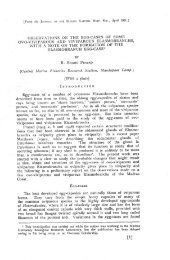PDF - Eprints@CMFRI
PDF - Eprints@CMFRI
PDF - Eprints@CMFRI
You also want an ePaper? Increase the reach of your titles
YUMPU automatically turns print PDFs into web optimized ePapers that Google loves.
53<br />
TIlS 1860. MIL'IE EDWARDS (& HAIME), 209.<br />
1879. KLUNZINGER 2, l6,pls. 515,6/9 , 10/8.<br />
1888, ORTMANN, ISS.<br />
Several specimens in the present material are referable to this species. The growth form varies as to<br />
encrusting , plate-like , massive with hillocks or even branching.<br />
NS 4922 is part of a sub massive corallum with a surface rising to hillocks. The papillae run together<br />
for considerable distance enclosing corallites between the valleys. The ridges thus formed are 4 to 6 mm<br />
thick and high. A few papillae remain free and are conical or tounded in shape. Calices about 1 mm in<br />
diameter with 12 septa.<br />
SLR 381 (also SLR 1187 and PW 71 342) are thick digitiform or flattened branches up to 9 mm in<br />
height and 2.5 mm in width. The papillae run together. The primary septa often fuse at the centre of the<br />
calicinal fossa.<br />
SLR 1176 is an encrusting growth with surface rising to small gibbosities. Papillae 3 to 4 mID thick<br />
and up to 7 mm high. SLR 353 is a circular disc-shaped specimen with a greater spread of 20 cm. It is<br />
formed of repeated encrustations. The papillae mostly remain single and are more or less similar to<br />
M. danae BERNARD .<br />
The outstanding feature of this species are the large papillae which generally run together to form<br />
ridges and valleys enclosing conspicuous large calices. In general the calices are deep, open and about 1 mm<br />
in diameter, but in some specimens (SLR 1176) they are smaller, 0.7 mm only. In one specimen, Wa 103<br />
from USNM, the papillae are not developed at all. It is a massive growth.<br />
Material :<br />
Gulf of Suez:<br />
Gulf of Aqaba :<br />
Northern R. S. :<br />
Central R. S.:<br />
T. Aviv NS 8380, 8418 (Ras el Kanisa).<br />
Jerus. SLR 1245* (Fara'un Isl.); 353*,381 (Marsa Murach); 11 76, 1187 (Marsa el<br />
Muqeibla) ; 487-1,2 (EI Kura); 654-2, 3 *, 656 (Marsa Abu Zabad).<br />
T. Aviv NS 1246*,8371 (Eilat); 1923 , 3067 (Marsa Murach) ; 4903 (Wassit);<br />
4910, 4922, 4969 (Dahab).<br />
Basel PW 73 516,73550 (Eilat); 71 341,71 342 (40m), 73545 (7 m)(Fara'un Isl.);<br />
HLM<br />
Jerus.<br />
USNM<br />
HLM<br />
P. Sud.<br />
HLM<br />
EC<br />
SLR<br />
Wa<br />
X2:<br />
Sa<br />
RM<br />
73638 (El Kura, 30- 33 m).<br />
1359-1362 (Aqaba).<br />
2172-1* (Sharm el Maya).<br />
5 l a (attached to Porites lutea), 103 (Ghardaqa).<br />
2- 33 (Gubal lsl., 9 m).<br />
14,57 (14 m), 58a (15 m, attached to Gyrosmilia interrupta),<br />
59 (13 m) (Sanganeb R.).<br />
69 (Wingate R.).<br />
(*f.danae)<br />
Dis t rib uti 0 n: The known distribution of M. meandrina is limited [0 Red Sea and Samaliland.<br />
However, forma danae is widely known from the Indo-Pacific.<br />
Rem ark s: From a close and critical study of the material at hand as well as of several others labelled<br />
as danae from different parts of the Indian Ocean we are of the opinion thatM. danae MILNE EDWARDS &<br />
HAIME is the same as M. meandrina. The difference is mainly in the growth form and in the size of the<br />
calices . However, there are specimens in the present material that show characters intermediate between<br />
the two. It is also worth mentioning that some specimens of M. meandrina show a tendency towards<br />
branching forms grading in M. spongiosa, though retain conspicuous papillae. The relationship of M.<br />
meandrina to M. spongiosa is still an open question.<br />
B. II. Papillate Montipora with ramose or tufted branching coralla.<br />
Montipora edwardsi BERNARD, 1897<br />
(Plate 10. Figs. 7. 8)<br />
Mo ntipora edwardsi 1897, BERNARD, 78 ; pis. 81l; 33114 (Typt: locality; Red Su).<br />
con/usa ? 1967. NEMENZO, 14 ; pl. 3/ 1,2.<br />
multilobata? 1860, MILNE EDWARDS & HAIME, 214 (after BERNARD).
















